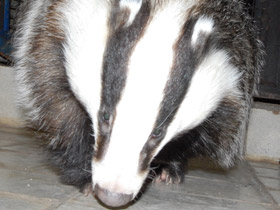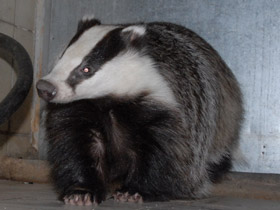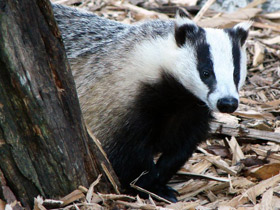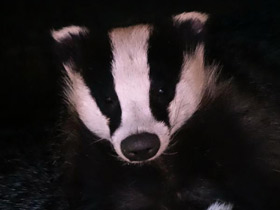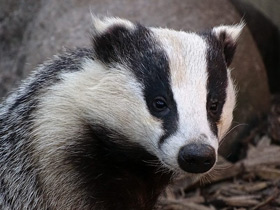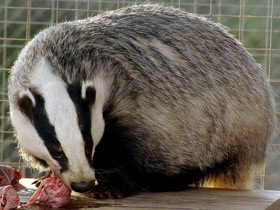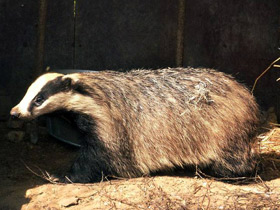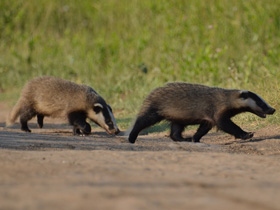The European badger or the Eurasian badger (Meles meles)
The European badger (Meles meles), also known as the Eurasian badger, is a badger species in the family Mustelidae native to Europe and West Asia and parts of Central Asia. It is classified as least concern on the IUCN Red List, as it has a wide range and a large, stable population size which is thought to be increasing in some regions. Several subspecies are recognized, with the nominate subspecies (Meles meles meles) predominating in most of Europe. In Europe, where no other badger species commonly occurs, it is generally just called the "badger".
Appearance
The Meles meles is a fairly large animal of the poultry family, with a heavy build and a very distinctive appearance. It is between 60 and 100 cm long and weighs between 7 and 13 kg in summer, increasing to 20-25 kg in autumn due to significant fat deposits. Its body has a peculiar wedge shape: its trunk narrows gradually towards the shoulders from broad, convex hindquarters, continuing with a relatively short neck and developing into a small, narrow, elongated head with very small, rounded ears, ending with an elongated movable nose. The tail is short, no more than a quarter of the length of the body. The legs are also short and massive, armed with strong elongated claws, and the feet are bare on the underside. All these external characteristics are related in one way or another to the adaptation of Meles meles to digging.
Lifestyle and behaviour
Meles meles is a sedentary animal, firmly attached to its burrow. Most of its life activity takes place within a radius of 400-500 m around its permanent home, i.e. an area of only about 100 ha. When food is abundant, Meles meles settle together, locating their burrows adjacent to each other on the same slope of the ravine. Vast individual habitats are found only where food is scarce, and in search of food the animal must travel 2-3 km from its burrow.
This animal leads a "semi-burrowed" lifestyle, spending most of the day in a burrow in summer and several months in winter. Meles meles always builds its dwelling by itself and throughout its life, almost continuously repairing underground constructions, widening and deepening them, and adding new openings. Therefore, a Meles meles burrow is sometimes very complicated: if 2 to 5 entrances lead to a new burrow, the old one can have up to 40-50 openings!
However, 2-3 main ones are constantly used, the rest serve as reserve holes for hiding in case of danger; sometimes badgers pass through them to get fresh air, to frolic among bushes and grass. There are also several ventilation shafts that open at some distance between bushes or grass. The underground part of the Meles meles burrow is a complex system of galleries, sometimes arranged on several levels, with numerous branches, dead ends, extensions and 1 or 2 nesting chambers. The total length of the underground passages of an average complex burrow reaches 35-80 m. The main chamber lies at the heart of these intricacies. It is lined with a thick bed of dried grasses, leaves and moss, which is renewed twice a year, in spring and autumn.
If the owners do not mind, the dens are "inherited" and each new generation contributes to the construction of a complex underground dwelling. The main efforts to improve the dwelling take place in autumn: the young animals dig new holes for themselves and the married couples prepare the old holes for the winter. An old "badger den", a space occupied by a large burrow, can occupy an area of up to one hectare. If conditions permit, Meles meles families have 2 or 3 burrows at a time, which the animals change, living in each burrow for 2-4 weeks.
Sometimes neighbouring burrows are connected by passages, forming entire "badger villages" populated by several families. Inhabitants communicate with each other peacefully, visiting the burrows of neighbours. The burrows of the Meles meles are a perfect habitat not only for their owners, but also for other animals. The fox lives in it as long as it does not disturb its master. When Meles meles does not like the neighbourhood, it simply chases the uninvited guest away: The stories or tales about the fox chasing Meles meles out of its den are not true. In some places, a raccoon dog sometimes lives in the burrow of Meles meles. In addition, abandoned badger dens are occasionally used as a refuge by feral cats, martens and polecats.
Of the senses, Meles meles has a well-developed sense of smell, which is its main means of orientation. Its eyesight is weak, as it only reacts to moving objects, and its hearing is no more acute than that of humans. Its quiet voice resembles a growl, in a state of irritation Meles meles growls sharply, during fights or attacks by predators it shrieks loudly. This animal is very clean; it digs special holes near the burrows or far away, in tall grass or bushes, so they are difficult to detect. The burrows of Meles meles are always quite clean, with no remains of uneaten food lying around, as is usual for foxes.
Meles meles hibernating in winter
In winter, Meles meles go into hibernation. As with bears, hibernation is not accompanied by a drop in body temperature or a slowing down of vital functions. In autumn, Meles meles accumulates large fat reserves, so that its weight almost doubles. At the time of burrowing, their burrow is already clean, the nesting chamber is full of fresh forage, and the entrance holes of Meles meles, when they climb into the burrow for the last time, are full of soil and leaves.
If several animals sleep in a common "badger house" for the winter, each of them sleeps in a separate nesting chamber. What a difference with raccoon polar bears!
The animals stop reappearing after the first snowfall (late October-November), but in very warm winters they are active as late as January. In areas that do not experience harsh winters with snow, Meles meles do not burrow for a long time, but hide for a few days when it is colder. In spring, the animals wake up with the thaw, when the average daily temperature is above freezing.
Nutrition
Meles meles is an omnivore, so it can hardly be considered a true predator. The first place in its diet is taken by insects, mainly large beetles - dung beetles, woodlouse beetles, crickets. It feeds on ground molluscs, mainly slugs, and, to a greater extent, earthworms. It also catches voles in the central belt, quite a few lizards in the arid southern areas and frogs in wet places. Plant foods, such as the soft green parts of plants, rhizomes and fruits, are also diverse. It eats almost all of them in any quantity, including forest berries in the central belt and fruits in the southern mountains. Interestingly, Meles meles does not eat carrion even in spring, when it is hungry, leaving unnoticed the remains of the feasts of large predators residing in the same area. It does, however, greedily pick fruits that have overwintered on the ground, such as apples, blueberries and acacia pods.
In search of food, Meles meles usually comes out at dusk and at night, preferring the moonless darkness. Only in the most remote places does it leave its underground shelter during the day, but it does not stray far from it, usually just lying near the entrance and basking in the sun. Unlike most wild animals, the Meles meles does not hide when it moves and makes a lot of noise: in dry seasons, when leaves and grasses dry up, it can usually be heard several tens of metres away. It makes a lot of noise by sniffing loudly and pecking the ground in search of food. The movements of Meles meles are usually slow and heavy. It walks with its head lowered to the ground, so that its apparently raised hindquarters make it look dejected. It usually walks at a slow pace or trot. Its tracks on wet ground look like miniature bear tracks and are difficult to mistake for anything else. Meles meles is a good swimmer, but rarely goes into the water when hunting.
Reproduction
In family relationships, Meles meles are very "clean". Their mates are formed for several years and possibly even for life. Mating takes place in early spring, just after the birth of the young, or in summer. Pregnancy is very delayed and lasts between 9 and 12 months. The gestation period is therefore from December to April (depending on local climatic conditions).
Females usually give birth to 2-3 young, weighing 70-80 grams, completely defenceless, blind and deaf, covered with white fur, with dark stripes on the head already clearly visible.
Until they are three months old, the young are exclusively breastfed and receive no nutrition. At this age, Meles meles hatchlings begin to come out of their holes and play in front of them in the presence of their parents and gradually begin to feed independently. Some of the Meles meles hatchlings leave the family in October, while others stay with their mother and roost with her during the winter.
Taxonomy
Ursus meles was the scientific name used by Carl Linnaeus in 1758, who described the badger in his work Systema Naturae
Evolution
The species likely evolved from the Chinese Meles thorali of the early Pleistocene. The modern species originated during the early Middle Pleistocene, with fossil sites occurring in Episcopia, Grombasek, Süssenborn, Hundsheim, Erpfingen, Koněprusy, Mosbach 2, and Stránská Skála. A comparison between fossil and living specimens shows a marked progressive adaptation to omnivory, namely in the increase in the molars' surface areas and the modification of the carnassials. Occasionally, badger bones are discovered in earlier strata, due to the burrowing habits of the species.
Systematics
Despite strong population and individual differentiation, some geographical variability can be noted for the whole species. Thus, when moving from the north to the south-east. In total, according to the reference book "Mammals of the fauna of Russia and neighbouring territories", more than 10 subspecies have been described, of which 4 inhabit the territory of the former USSR (2 in Russia):
- Meles meles meles L., 1758 - European forest badger, Eastern and Western Europe, forest zone;
- Meles meles marianensis - Iberian badger, Spain and Portugal;
- Meles meles canescens BLANFORD, 1875 - Transcaucasian badger, or small European badger, [syn. minor SATUNIN, 1905], Foreland and Central Asia, also defined as a separate species due to strong genetic differences;
- Meles meles leptorynchus, Russia;
- Meles meles severzovi HEPTNER, 1940 - Fergana European badger, inhabits the mountainous regions of southern Uzbekistan and Tajikistan;
- Meles meles arcalus - Cretan badger, found on the island of the same name;
- Meles meles rhodicus - Rhodesian badger, found on the island of the same name;
- Meles meles heptneri OGNEV, 1931 - European steppe badger, or Kizlyar badger [syn. caucascius OGNEV, 1926], [syn. tauricus OGNEV, 1926], steppes of Eastern Europe and North-Eastern Caucasia, Kalmykia, Volga delta;
- Previously, the Asian badger (lat. Meles leucurus) and Japanese badger (lat. Meles anakuma) were classified as sub-species of the common badger.

















